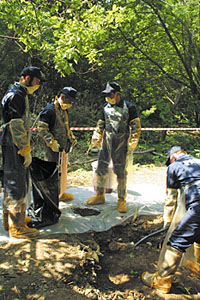Collecting
Collecting
While planning organization and technical measures on separate waste collecting, the following factors should be taken into account:
- physical and chemical characteristics of waste;
- type and half-life of radionuclides contained in waste;
- radionuclide concentration;
- waste acceptability for particular processing methods;
- possible or available methods for storage and disposal.
Waste nature and composition is defined to a large content (and sometimes substantially) by generation source. For example, in many cases of using radioactive materials, particularly in medicine and research activities, a certain radionuclide is almost always used in certain procedures. It’s clear that in this case it’s quite easy to collect waste separately according to its radionuclide composition. However, it’s more complicated to separate radioactive waste generated at nuclear fuel cycle enterprises under this factor, since this waste may initially contain mixture of radionuclides. In this case waste separation should be based on results of analysis of waste radiochemical characteristics and specific activity or pollution level. Determination of waste radiochemical characteristics at the collecting stage is used – as at all waste management stages – also for taking appropriate measures for radiation safety. It’s necessary to obtain corresponding measuring equipment and working knowledge of techniques for direct and indirect measurements, taking or preparing samples in order to measure waste activity. It particularly important in conversion of decontaminated objects, equipment or materials to non-radioactive, since their very low level of activity should be proved by measurements – and the lower control levels are, the more complicated the measurements are. For direct measurements we use different ionizing radiation detectors situated in immediate proximity of object measured. Indirect measurements method consists in determination of level of non-fixed or weakly fixed contamination of the smear taken from a surface (contamination level is determined by direct measurement). Wastes containing radionuclides with half-life less than 15 days (under Regulations of the Russian Federation) are collected separately from other radwastes and are kept in temporary storages of the organization dealing with waste collecting. After activity is decreased till decontrol levels, solid wastes are disposed like industrial waste and liquid waste may be returned to water recycling system or poured into sewage system under compulsory radiation control. It should be noted that if these wastes are chemically and biologically dangerous, than their discharge without extra treatment is unacceptable. Problems concerning separate collecting of solid and liquid waste with half-life period more than indicated above are examined later.

















